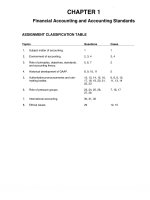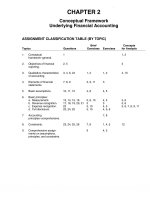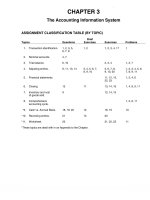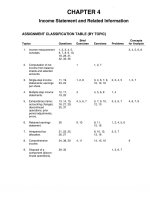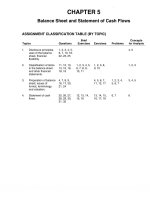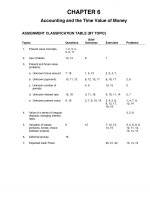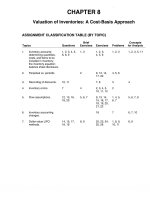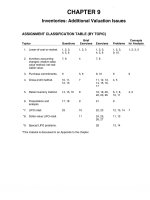Solution manual intermediate accounting 13e kieso ch05
Bạn đang xem bản rút gọn của tài liệu. Xem và tải ngay bản đầy đủ của tài liệu tại đây (480.24 KB, 82 trang )
To download more slides, ebook, solutions and test bank, visit
CHAPTER 5
Balance Sheet and Statement of Cash Flows
ASSIGNMENT CLASSIFICATION TABLE (BY TOPIC)
Topics
Questions
1.
Disclosure principles,
uses of the balance
sheet, financial
flexibility.
1, 2, 3, 4, 5,
6, 7, 10, 18,
22, 23, 25
2.
Classification of items
in the balance sheet
and other financial
statements.
11, 12, 13,
14, 15, 16,
18, 19
3.
Preparation of balance
sheet; issues of
format, terminology,
and valuation.
4, 7, 8, 9,
16, 17, 20,
21, 24
4.
Statement of cash
flows.
25, 26, 27,
28, 29, 30,
31, 32
Copyright © 2010 John Wiley & Sons, Inc.
Brief
Exercises
Exercises
Problems
Concepts
for Analysis
4, 5
1, 2, 3, 4, 5,
6, 7, 8, 9,
10, 11
12, 13, 14,
15, 16
1, 2, 3, 8,
9, 10
1, 2, 3
4, 5, 6, 7,
11, 12, 17
1, 2, 3, 4,
5, 6, 7
3, 4, 5
13, 14, 15,
16, 17, 18
6, 7
6
Kieso, Intermediate Accounting, 13/e, Solutions Manual
(For Instructor Use Only)
5-1
To download more slides, ebook, solutions and test bank, visit
ASSIGNMENT CLASSIFICATION TABLE (BY LEARNING OBJECTIVE)
Brief
Exercises
Learning Objectives
Exercises
Problems
1.
Explain the uses and limitations of a
balance sheet.
2.
Identify the major classifications of the
balance sheet.
3.
Prepare a classified balance sheet using
the report and account formats.
4.
Determine which balance sheet information
requires supplemental disclosure.
5.
Describe the major disclosure techniques
for the balance sheet.
6.
Indicate the purpose of the statement
of cash flows.
7.
Identify the content of the statement
of cash flows.
8.
Prepare a basic statement of cash flows.
12, 13, 14, 15
14, 15, 16,
17, 18
6, 7
9.
Understand the usefulness of the statement
of cash flows.
12, 16
15, 16, 18
6, 7
5-2
Copyright © 2010 John Wiley & Sons, Inc.
7
1, 2, 3,
4, 8, 9
1, 2, 3, 4, 5,
6, 7, 8, 9,
10, 11
1, 2, 3, 4, 5,
6, 7, 9, 10,
11, 12, 17
1, 2, 3, 4,
5, 6, 7
10
4
13
Kieso, Intermediate Accounting, 13/e, Solutions Manual
(For Instructor Use Only)
To download more slides, ebook, solutions and test bank, visit
ASSIGNMENT CHARACTERISTICS TABLE
Level of
Difficulty
Time
(minutes)
Balance sheet classifications.
Classification of balance sheet accounts.
Classification of balance sheet accounts.
Preparation of a classified balance sheet.
Preparation of a corrected balance sheet.
Corrections of a balance sheet.
Current assets section of the balance sheet.
Current vs. long-term liabilities.
Current assets and current liabilities.
Current liabilities.
Balance sheet preparation.
Preparation of a balance sheet.
Statement of cash flows—classifications.
Preparation of a statement of cash flows.
Preparation of a statement of cash flows.
Preparation of a statement of cash flows.
Preparation of a statement of cash flows and a
balance sheet.
Preparation of a statement of cash flows, analysis.
Simple
Simple
Simple
Simple
Simple
Complex
Moderate
Moderate
Complex
Moderate
Moderate
Moderate
Moderate
Moderate
Moderate
Moderate
Moderate
15–20
15–20
15–20
30–35
30–35
30–35
15–20
10–15
30–35
15–20
25–30
30–35
15–20
25–35
25–35
25–35
30–35
Moderate
25–35
Preparation of a classified balance sheet, periodic
inventory.
Balance sheet preparation.
Balance sheet adjustment and preparation.
Preparation of a corrected balance sheet.
Balance sheet adjustment and preparation.
Preparation of a statement of cash flows and
a balance sheet.
Preparation of a statement of cash flows and
a balance sheet.
Moderate
30–35
Moderate
Moderate
Complex
Complex
Complex
35–40
40–45
40–45
40–50
35–45
Complex
40–50
Reporting for financial effects of varied transactions.
Current asset and liability classification.
Identifying balance sheet deficiencies.
Critique of balance sheet format and content.
Presentation of property, plant, and equipment.
Cash flow analysis.
Moderate
Moderate
Moderate
Simple
Simple
Complex
25–30
30–35
20–25
25–30
20–25
40–50
Item
Description
E5-1
E5-2
E5-3
E5-4
E5-5
E5-6
E5-7
E5-8
E5-9
E5-10
E5-11
E5-12
E5-13
E5-14
E5-15
E5-16
E5-17
E5-18
P5-1
P5-2
P5-3
P5-4
P5-5
P5-6
P5-7
CA5-1
CA5-2
CA5-3
CA5-4
CA5-5
CA5-6
Copyright © 2010 John Wiley & Sons, Inc.
Kieso, Intermediate Accounting, 13/e, Solutions Manual
(For Instructor Use Only)
5-3
To download more slides, ebook, solutions and test bank, visit
SOLUTIONS TO CODIFICATION EXERCISES
CE5-1
(a) Current assets is used to designate cash and other assets or resources commonly identified as
those that are reasonably expected to be realizes in cash or sold or consumed during the normal
operating cycle of the business.
(b) Intangible Assets are assets (not including financial assets) that lack physical substance. (The
term intangible assets is used to refer to intangible assets other than goodwill.) Clicking on the first
link yields the following FASB ASC string: 350 Intangibles—Goodwill and Other > 10 Overall.
(c)
Cash equivalents are short-term, highly liquid investments that have both of the following
characteristics:
a.
Readily convertible to known amounts of cash
b.
So near their maturity that they present insignificant risk of changes in value because of
changes in interest rates.
Generally, only investments with original maturities of three months or less qualify under that
definition. Original maturity means original maturity to the entity holding the investment. For
example, both a three-month U.S. Treasury bill and a three-year Treasury note purchased three
months from maturity qualify as cash equivalents. However, a Treasury note purchased three years
ago does not become a cash equivalent when its remaining maturity is three moths. Examples of
items commonly considered to be cash equivalents are Treasury bills, commercial paper, money
market funds, and federal funds sold (for an entity with banking operations).
(d) Financing activities include obtaining resources from owners and providing them with a return on,
and a return of, their investment; receiving restricted resources that by donor stipulation must be
used for long-term purposes; borrowing money and repaying amounts borrowed, or otherwise
settling the obligation; and obtaining and paying for other resources obtained from creditors on
long-term credit.
CE5-2
See FASC ASC 210-10-45 (Other Presentation Matters)
Classification of Current Liabilities
45-5A
Total of current liabilities shall be presented in classified balance sheets.
45-6
The concept of current liabilities shall include estimated or accrued amounts that are expected
to be required to cover expenditures within the year for known obligations the amount of which
can be determined only approximately (as in the case of provisions for accruing bonus
payments) or where the specific person or persons to whom payment will be made cannot as
yet be designated (as in the case of estimated costs to be incurred in connection with
guaranteed servicing or repair of products already sold).
5-4
Copyright © 2010 John Wiley & Sons, Inc.
Kieso, Intermediate Accounting, 13/e, Solutions Manual
(For Instructor Use Only)
To download more slides, ebook, solutions and test bank, visit
CE5-2 (Continued)
45-7
Section 470-10-45 includes guidance on various debt transactions that may result in current
liability classification. These transactions are the following:
a.
b.
c.
Due on demand loan agreements
Callable debt agreements
Short-term obligations expected to be refinanced.
CE5-3
The following discussion is provided at 235-10-50 Disclosure
> Accounting Policies Disclosure
50-1
Information about the accounting policies adopted by an entity is essential for financial
statement users. When financial statements are issued purporting to present fairly financial
position, cash flows, and results of operations in accordance with generally accepted
accounting principles (GAAP), a description of all significant accounting policies of the entity
shall be included as an integral part of the financial statements. In circumstances where it may
be appropriate to issue one or more of the basic financial statements without the others,
purporting to present fairly the information given in accordance with GAAP, statements so
presented also shall include disclosure of the pertinent accounting policies.
> Accounting Policies Disclosure in Interim Periods
50-2
The provisions of the preceding paragraph are not intended to apply to unaudited financial
statements issued as of a date between annual reporting dates (for example, each quarter) if
the reporting entity has not changed its accounting policies since the end of its preceding
fiscal year.
> What to Disclose
50-3
Disclosure of accounting policies shall identify and describe the accounting principles followed
by the entity and the methods of applying those principles that materially affect the determination of financial position, cash flows, or results of operations. In general, the disclosure shall
encompass important judgments as to appropriateness of principles relating to recognition of
revenue and allocation of asset costs to current and future periods; in particular, it shall
encompass those accounting principles and methods that involve any of the following:
a.
b.
c.
A selection from existing acceptable alternatives
Principles and methods peculiar to the industry in which the entity operations, even if
such principles and methods are predominantly followed in that industry
Unusual or innovative applications of GAAP.
> Examples of Disclosures
50-4
Examples of disclosures by an entity commonly required with respect to accounting policies
would include, among others, those relating to the following:
a.
b.
Basis of consolidation
Depreciation methods
Copyright © 2010 John Wiley & Sons, Inc.
Kieso, Intermediate Accounting, 13/e, Solutions Manual
(For Instructor Use Only)
5-5
To download more slides, ebook, solutions and test bank, visit
CE5-3 (Continued)
c.
d.
e.
f.
Amortization of intangibles
Inventory pricing
Accounting for recognition of profit on long-term construction-type contracts
Recognition of revenue from franchising and leasing operations.
> Avoid Duplicate Details of Disclosures
50-5
Financial statement disclosure of accounting policies shall not duplicate details (for example,
composition of inventories or of plant assets) presented elsewhere as part of the financial
statements. In some cases, the disclosure of accounting policies shall refer to related details
presented elsewhere as part of the financial statements; for example, changes in accounting
policies during the period shall be described with cross-reference to the disclosure required by
Topic 250.
> Format
50-6
This Subtopic recognizes the need for flexibility in matters of format (including the location) of
disclosure of accounting policies provided that the entity identifies and describes its significant
accounting policies as an integral part of its financial statements in accordance with the provisions of this Subtopic. Disclosure is preferred in a separate summary of significant accounting
policies preceding the notes to financial statements, or as the initial note, under the same or a
similar title.
CE5-4
The following section: 230-10-05 Overview and Background provides a discussion of the objectives for
the Statement of Cash Flows.
05-1
The Statement of Cash Flows Topic presents standards for reporting cash flows in generalpurpose financial statements.
05-2
Specific guidance is provided on all of the following:
a.
b.
c.
d.
Classifying in the statement of cash flows of cash receipts and payments as either
operating, investing, or financing activities
Applying the direct method and the indirect method of reporting cash flows
Presenting the required information about noncash investing and financing activity and
other events
Classifying cash receipts and payments related to hedging activities.
230-10-10 Objectives
10-1
5-6
The primary objective of a statement of cash flows is to provide relevant information about the
cash receipts and cash payments of an entity during a period.
Copyright © 2010 John Wiley & Sons, Inc.
Kieso, Intermediate Accounting, 13/e, Solutions Manual
(For Instructor Use Only)
To download more slides, ebook, solutions and test bank, visit
CE5-4 (Continued)
10-2
The information provided in a statement of cash flows, if used with related disclosures and
information in the other financial statements, should help investors, creditors, and others (including
donors) to do all of the following:
a.
b.
c.
d.
Assess the entity’s ability to generate positive future net cash flows
Assess the entity’s ability to meet its obligations, its ability to pay dividends, and its
needs for external financing
Assess the reasons for differences between net income and associated cash receipts
and payments
Assess the effects on an entity’s financial position of both its cash and noncash investing
and financing transactions during the period.
Copyright © 2010 John Wiley & Sons, Inc.
Kieso, Intermediate Accounting, 13/e, Solutions Manual
(For Instructor Use Only)
5-7
To download more slides, ebook, solutions and test bank, visit
ANSWERS TO QUESTIONS
1. The balance sheet provides information about the nature and amounts of investments in enterprise
resources, obligations to enterprise creditors, and the owners’ equity in net enterprise resources.
That information not only complements information about the components of income, but also
contributes to financial reporting by providing a basis for (1) computing rates of return, (2) evaluating
the capital structure of the enterprise, and (3) assessing the liquidity and financial flexibility of the
enterprise.
2. Solvency refers to the ability of an enterprise to pay its debts as they mature. For example, when a
company carries a high level of long-term debt relative to assets, it has lower solvency. Information
on long-term obligations, such as long-term debt and notes payable, in comparison to total assets
can be used to assess resources that will be needed to meet these fixed obligations (such as
interest and principal payments).
3. Financial flexibility is the ability of an enterprise to take effective actions to alter the amounts and
timing of cash flows so it can respond to unexpected needs and opportunities. An enterprise with a
high degree of financial flexibility is better able to survive bad times, to recover from unexpected
setbacks, and to take advantage of profitable and unexpected investment opportunities. Generally,
the greater the financial flexibility, the lower the risk of enterprise failure.
4. Some situations in which estimates affect amounts reported in the balance sheet include:
(a)
allowance for doubtful accounts.
(b)
depreciable lives and estimated salvage values for plant and equipment.
(c)
warranty returns.
(d)
determining the amount of revenues that should be recorded as unearned.
When estimates are required, there is subjectivity in determining the amounts. Such subjectivity
can impact the usefulness of the information by reducing the reliability of the measures, either
because of bias or lack of verifiability.
5. An increase in inventories increases current assets, which is in the numerator of the current ratio.
Therefore, inventory increases will increase the current ratio. In general, an increase in the current
ratio indicates a company has better liquidity, since there are more current assets relative to
current liabilities.
Note to instructors—When inventories increase faster than sales, this may not be a good signal
about liquidity. That is, inventory can only be used to meet current obligations when it is sold (and
converted to cash). That is why some analysts use a liquidity ratio—the acid test ratio—that excludes
inventories from current assets in the numerator.
6. Liquidity describes the amount of time that is expected to elapse until an asset is converted into
cash or until a liability has to be paid. The ranking of the assets given in order of liquidity is:
(1) (d) Short-term investments.
(2) (e) Accounts receivable.
(3) (b) Inventories.
(4) (c) Buildings.
(5) (a) Goodwill.
7. The major limitations of the balance sheet are:
(a)
The values stated are generally historical and not at fair value.
(b)
Estimates have to be used in many instances, such as in the determination of collectibility of
receivables or finding the approximate useful life of long-term tangible and intangible assets.
(c)
Many items, even though they have financial value to the business, presently are not
recorded. One example is the value of a company’s human resources.
5-8
Copyright © 2010 John Wiley & Sons, Inc.
Kieso, Intermediate Accounting, 13/e, Solutions Manual
(For Instructor Use Only)
To download more slides, ebook, solutions and test bank, visit
Questions Chapter 5 (Continued)
8. Some items of value to technology companies such as Intel or IBM are the value of research and
development (new products that are being developed but which are not yet marketable), the value
of the “intellectual capital” of its workforce (the ability of the companies’ employees to come up with
new ideas and products in the fast changing technology industry), and the value of the company
reputation or name brand (e.g., the “Intel Inside” logo). In most cases, the reasons why the value
of these items are not recorded in the balance sheet concern the lack of reliability of the estimates
of the future cash flows that will be generated by these “assets” (for all three types) and the ability
to control the use of the asset (in the case of employees). Being able to reliably measure the
expected future benefits and to control the use of an item are essential elements of the definition
of an asset, according to the Conceptual Framework.
9. Classification in financial statements helps users by grouping items with similar characteristics and
separating items with different characteristics. Current assets are expected to be converted to
cash within one year or one operating cycle, whichever is longer—property, plant and equipment
will provide cash inflows over a longer period of time. Thus, separating long-term assets from
current assets facilitates computation of useful ratios such as the current ratio.
10. Separate amounts should be reported for accounts receivable and notes receivable. The amounts
should be reported gross, and an amount for the allowance for doubtful accounts should be
deducted. The amount and nature of any nontrade receivables, and any amounts designated or
pledged as collateral, should be clearly identified.
11. No. Available-for-sale securities should be reported as a current asset only if management expects
to convert them into cash as needed within one year or the operating cycle, whichever is longer. If
available-for-sale securities are not held with this expectation, they should be reported as longterm investments.
12. The relationship between current assets and current liabilities is that current liabilities are those
obligations that are reasonably expected to be liquidated either through the use of current assets
or the creation of other current liabilities.
13. The total selling price of the season tickets is $20,000,000 (10,000 X $2,000). Of this amount,
$8,000,000 has been earned by 12/31/10 (16/40 X $20,000,000). The remaining $12,000,000
should be reported as unearned revenue, a current liability in the 12/31/10 balance sheet (24/40 X
$20,000,000).
14. Working capital is the excess of total current assets over total current liabilities. This excess is
sometimes called net working capital. Working capital represents the net amount of a company’s
relatively liquid resources. That is, it is the liquidity buffer available to meet the financial demands of
the operating cycle.
15. (a)
(b)
(c)
(d)
(e)
(f)
(g)
(h)
(i)
Stockholders’ Equity. “Treasury stock (at cost).”
Note: This is a reduction of total stockholders’ equity.
Current Assets. Included in “Cash.”
Investments. “Land held as an investment.”
Investments. “Sinking fund.”
Long-term debt (adjunct account to bonds payable). “Unamortized premium on bonds payable.”
Intangible Assets. “Copyrights.”
Investments. “Employees’ pension fund,” with subcaptions of “Cash” and “Securities” if desired.
(Assumes that the company still owns these assets.)
Stockholders’ Equity. “Premium on capital stock” or “Additional paid-in capital in excess of
par value.”
Investments. Nature of investments should be given together with parenthetical information
as follows: “pledged to secure loans payable to banks.”
Copyright © 2010 John Wiley & Sons, Inc.
Kieso, Intermediate Accounting, 13/e, Solutions Manual
(For Instructor Use Only)
5-9
To download more slides, ebook, solutions and test bank, visit
Questions Chapter 5 (Continued)
16. (a)
(b)
(c)
(d)
(e)
(f)
(g)
(h)
(i)
17. (a)
(b)
(c)
(d)
(e)
Allowance for doubtful accounts receivable should be deducted from accounts receivable in
current assets.
Merchandise held on consignment should not appear on the consignee’s balance sheet
except possibly as a note to the financial statements.
Advances received on sales contract are normally a current liability and should be shown as
such in the balance sheet.
Cash surrender value of life insurance should be shown as a long-term investment.
Land should be reported in property, plant, and equipment unless held for investment.
Merchandise out on consignment should be shown among current assets under the heading
of inventories.
Franchises should be itemized in a section for intangible assets.
Accumulated depreciation of plant and equipment should be deducted from the plant and
equipment accounts.
Materials in transit should not be shown on the balance sheet of the buyer, if purchased
f.o.b. destination.
Trade accounts receivable should be stated at their estimated amount collectible, often
referred to as net realizable value. The method most generally followed is to deduct from the
total accounts receivable the amount of the allowance for doubtful accounts.
Land is generally stated in the balance sheet at cost.
Inventories are generally stated at the lower of cost or market.
Trading securities (consisting of common stock of other companies) are stated at fair value.
Prepaid expenses should be stated at cost less the amount apportioned to and written off
over the previous accounting periods.
18. Assets are defined as probable future economic benefits obtained or controlled by a particular
entity as a result of past transactions or events. If a building is leased under a capital lease, the
future economic benefits of using the building are controlled by the lessee (tenant) as the result of
a past event (the signing of a lease agreement).
19. Battle is incorrect. Retained earnings is a source of assets, but is not an asset itself. For example,
even though the funds obtained from issuing a note payable are invested in the business, the note
payable is not reported as an asset. It is a source of assets, but it is reported as a liability because
the company has an obligation to repay the note in the future. Similarly, even though the earnings
are invested in the business, retained earnings is not reported as an asset. It is reported as part of
stockholders’ equity because it is, in effect, an investment by owners which increases the ownership
interest in the assets of an entity.
20. The notes should appear as long-term liabilities with full disclosure as to their terms. Each year, as
the profit is determined, notes of an amount equal to two-thirds of the year’s profits should be
transferred from the long-term liabilities to current liabilities until all of the notes have been
liquidated.
21. Some of the techniques of disclosure for the balance sheet are:
(a)
Parenthetical explanations.
(b)
Notes to the financial statements.
(c)
Cross references and contra items.
(d)
Supporting schedules.
5-10
Copyright © 2010 John Wiley & Sons, Inc.
Kieso, Intermediate Accounting, 13/e, Solutions Manual
(For Instructor Use Only)
To download more slides, ebook, solutions and test bank, visit
Questions Chapter 5 (Continued)
22. A note entitled “Summary of Significant Accounting Policies” would indicate the basic accounting
principles used by that enterprise. This note should be very useful from a comparative standpoint,
since it should be easy to determine whether the company uses the same accounting policies as
other companies in the same industry.
23. General debt obligations, lease contracts, pension arrangements and stock option plans are four
items for which disclosure is mandatory in the financial statements. The reason for disclosing
these contractual situations is that these commitments are of a long-term nature, are often
significant in amount, and are very important to the company’s well-being.
24. The profession has recommended that the use of the word “surplus” be discontinued in balance
sheet presentations of owners’ equity. This term has a connotation outside accounting that is quite
different from its meaning in the accounts or in the balance sheet. The use of the terms capital
surplus, paid-in surplus, and earned surplus is confusing to the nonaccountant and leads to
misinterpretation.
25. The purpose of a statement of cash flows is to provide relevant information about the cash receipts
and cash payments of an enterprise during a period. It differs from the balance sheet and the
income statement in that it reports the sources and uses of cash by operating, investing, and
financing activity classifications. While the income statement and the balance sheet are accrual
basis statements, the statement of cash flows is a cash basis statement—noncash items are
omitted.
26. The difference between these two amounts may be due to increases in current assets (e.g., an
increase in accounts receivable from a sale on account would result in an increase in revenue and
net income but have no effect yet on cash). Similarly a cash payment that results in a decrease in
an existing current liability (e.g., accounts payable would decrease cash provided by operations
without affecting net income.)
27. The difference between these two amounts could be due to noncash charges that appear in the
income statement. Examples of noncash charges are depreciation, depletion, and amortization of
intangibles. Expenses recorded but unpaid (e.g., increase in accounts payable) and collection of
previously recorded sales on credit (i.e., now decreasing accounts receivable) also would cause
cash provided by operating activities to exceed net income.
28. Operating activities involve the cash effects of transactions that enter into the determination of
net income. Investing activities include making and collecting loans and acquiring and disposing
of debt and equity instruments; property, plant, and equipment and intangibles. Financing activities
involve liability and owners’ equity items and include obtaining capital from owners and providing
them with a return on (dividends) and a return of their investment and borrowing money from
creditors and repaying the amounts borrowed.
29. (a)
(b)
Net income is adjusted downward by deducting $5,000 from $90,000 and reporting cash
provided by operating activities as $85,000.
The issuance of the preferred stock is a financing activity. The issuance is reported as
follows:
Cash flows from financing activities
Issuance of preferred stock .....................................................................
$1,150,000
Copyright © 2010 John Wiley & Sons, Inc.
Kieso, Intermediate Accounting, 13/e, Solutions Manual
(For Instructor Use Only)
5-11
To download more slides, ebook, solutions and test bank, visit
Questions Chapter 5 (Continued)
(c)
(d)
Net income is adjusted as follows:
Cash flows from operating activities
Net income...................................................................................................
Adjustments to reconcile net income to net
cash provided by operating activities:
Depreciation expense ..........................................................................
Premium amortization..........................................................................
Net cash provided by operating activities..............................................
$90,000
14,000
(5,000)
$99,000
The increase of $20,000 reflects an investing activity. The increase in Land is reported as
follows:
Cash flows from investing activities:
Investment in Land ...............................................................................
$(20,000)
30. The company appears to have good liquidity and reasonable financial flexibility. Its current cash
$1,200,000
debt coverage ratio is 1.20
, which indicates that it can pay off its current liabilities in
$1,000,000
a given year from its operations. In addition, its cash debt coverage ratio is also good at
$1,200,000
0.80
, which indicates that it can pay off approximately 80% of its debt out of current
$1,500,000
operations.
31. Free cash flow = $860,000 – $75,000 – $30,000 = $755,000.
32. Free cash flow is net cash provided by operating activities less capital expenditures and dividends.
The purpose of free cash flow analysis is to determine the amount of discretionary cash flow a
company has for purchasing additional investments, retiring its debt, purchasing treasury stock, or
simply adding to its liquidity and financial flexibility.
33. In general, the disclosure requirements related to the balance sheet and the statement of cash flows
are much more extensive and detailed in the U.S. IAS 1, “Presentation of Financial Statements,”
provides the overall iGAAP requirements for balance sheet information. IAS 7, “Cash Flow
Statements,” provides the overall iGAAP requirements cash flow information.
34. Among the similarities between U.S. and iGAAP related to balance sheet presentation are as follows:
•
•
•
IAS 1 specifies minimum note disclosures. These must include information about (1) accounting
policies followed, (2) judgments that management has made in the process of applying the
entity’s accounting policies, and (3) and the key assumptions and estimation uncertainty that
could result in a material adjustment to the carrying amounts of assets and liabilities within the
next financial year.
Comparative prior-period information must be presented and financial statements must be
prepared annually.
Current/non-current classification for assets and liabilities is normally required. In general,
post-balance sheet events are not considered in classifying items as current or non-current.
Differences include (1) iGAAP statements may report property, plant, and equipment first in the
balance sheet. Some companies report the sub-total “net assets”, which equals total assets minus
total liabilities. (2) While the use of the term “reserve” is discouraged in U.S. GAAP, there is no
such prohibition in iGAAP.
5-12
Copyright © 2010 John Wiley & Sons, Inc.
Kieso, Intermediate Accounting, 13/e, Solutions Manual
(For Instructor Use Only)
To download more slides, ebook, solutions and test bank, visit
Questions Chapter 5 (Continued)
35. The IASB and the FASB are working on a project to converge their standards related to financial
statement presentation. This joint project will establish a common, high-quality standard for
presentation of information in the financial statements, including the classification and display of
line items. A key feature of the proposed framework for financial statement presentation is that
each of the statements will be organized in the same format to separate an entity’s financing
activities from its operating and other activities (investing) and further separates financing activities
into transactions with owners and creditors. Thus, the same classifications used in the balance
sheet would also be used in the income statement and the statement of cash flows. The project
has three phases. You can follow the joint financial presentation project at the following link:
/>36. Rainmaker Company will report a net revaluation gain of 165,000 Euros (200,000 Euros—35,000
Euros), which will be recoded as an adjustment to these assets with the net gain recorded in
equity. Each reporting period the property and equipment are revalued to approximate fair value.
The use of revaluations is prohibited in U.S. GAAP.
Copyright © 2010 John Wiley & Sons, Inc.
Kieso, Intermediate Accounting, 13/e, Solutions Manual
(For Instructor Use Only)
5-13
To download more slides, ebook, solutions and test bank, visit
SOLUTIONS TO BRIEF EXERCISES
BRIEF EXERCISE 5-1
Current assets
Cash...............................................................................
Accounts receivable ................................................
Less: Allowance for doubtful accounts......
$ 30,000
$110,000
(8,000)
102,000
Inventories...................................................................
Prepaid insurance.....................................................
290,000
9,500
Total current assets ...................................
$431,500
BRIEF EXERCISE 5-2
Current assets
Cash...............................................................................
$
Trading securities.....................................................
Accounts receivable ................................................
Less: Allowance for doubtful accounts......
7,000
11,000
$90,000
(4,000)
86,000
Inventory ......................................................................
30,000
Prepaid insurance.....................................................
5,200
Total current assets ...................................
$139,200
BRIEF EXERCISE 5-3
Long-term investments
5-14
Held-to-maturity securities ....................................
Land held for investment .......................................
$ 56,000
39,000
Long-term note receivables...................................
Total investments...............................................
42,000
$137,000
Copyright © 2010 John Wiley & Sons, Inc.
Kieso, Intermediate Accounting, 13/e, Solutions Manual
(For Instructor Use Only)
To download more slides, ebook, solutions and test bank, visit
BRIEF EXERCISE 5-4
Property, plant, and equipment
Land ...............................................................................
Buildings ......................................................................
$ 71,000
$207,000
Less: Accumulated depreciation...................
Equipment....................................................................
(45,000)
162,000
$190,000
Less: Accumulated depreciation .................
(19,000)
Timberland...................................................................
171,000
70,000
Total property, plant, and equipment......
$474,000
BRIEF EXERCISE 5-5
Intangible assets
Goodwill........................................................................
$150,000
Patents ..........................................................................
Franchises ...................................................................
220,000
130,000
Total intangibles .................................................
$500,000
BRIEF EXERCISE 5-6
Intangible assets
Goodwill........................................................................
$ 50,000
Franchises ...................................................................
47,000
Patents ..........................................................................
33,000
Trademarks..................................................................
Total intangible assets......................................
10,000
$140,000
Copyright © 2010 John Wiley & Sons, Inc.
Kieso, Intermediate Accounting, 13/e, Solutions Manual
(For Instructor Use Only)
5-15
To download more slides, ebook, solutions and test bank, visit
BRIEF EXERCISE 5-7
Current liabilities
Notes payable.............................................................
Accounts payable .....................................................
$ 22,500
72,000
Accrued salaries .......................................................
Income taxes payable..............................................
4,000
7,000
Total current liabilities...............................
$105,500
BRIEF EXERCISE 5-8
Current liabilities
Accounts payable .....................................................
$220,000
Advances from customers.....................................
41,000
Wages payable...........................................................
27,000
Interest payable .........................................................
Income taxes payable..............................................
12,000
29,000
Total current liabilities...............................
$329,000
BRIEF EXERCISE 5-9
Long-term liabilities
5-16
Bonds payable ...........................................................
$400,000
Less: Discount on bonds payable................
29,000
Pension liability .........................................................
$371,000
375,000
Total long-term liabilities..........................
$746,000
Copyright © 2010 John Wiley & Sons, Inc.
Kieso, Intermediate Accounting, 13/e, Solutions Manual
(For Instructor Use Only)
To download more slides, ebook, solutions and test bank, visit
BRIEF EXERCISE 5-10
Stockholders’ equity
Common stock ...........................................................
Additional paid-in capital........................................
$750,000
200,000
Retained earnings .....................................................
Accumulated other comprehensive loss...........
120,000
(150,000)
Total stockholders’ equity ................................
$920,000
BRIEF EXERCISE 5-11
Stockholders’ equity
Preferred stock...........................................................
$152,000
Common stock ...........................................................
Additional paid-in capital........................................
55,000
174,000
Retained earnings .....................................................
114,000
Total stockholders’ equity ................................
$495,000
BRIEF EXERCISE 5-12
Cash Flow Statement
Operating Activities
Net income.....................................................................
Depreciation expense ................................................
$40,000
4,000
Increase in accounts receivable ............................
Increase in accounts payable .................................
(10,000)
7,000
Net cash provided by operating activities .......
Copyright © 2010 John Wiley & Sons, Inc.
Kieso, Intermediate Accounting, 13/e, Solutions Manual
41,000
(For Instructor Use Only)
5-17
To download more slides, ebook, solutions and test bank, visit
BRIEF EXERCISE 5-12 (Continued)
Investing Activities
Purchase of equipment ............................................
(8,000)
Financing Activities
Issue notes payable...................................................
Dividends ......................................................................
20,000
(5,000)
Net cash flow from financing activities........
Net change in cash ($41,000 – $8,000 + $15,000).........
15,000
$48,000
Free Cash Flow = $41,000 (Net cash provided by operating activities) –
$8,000 (Purchase of equipment) – $5,000 (Dividends) = $28,000.
BRIEF EXERCISE 5-13
Cash flows from operating activities
Net income....................................................................
Adjustments to reconcile net income to
net cash provided by operating activities
Depreciation expense.........................................
Increase in accounts payable..........................
Increase in accounts receivable .....................
$151,000
$44,000
9,500
(13,000)
Net cash provided by operating activities..........
40,500
$191,500
BRIEF EXERCISE 5-14
Sale of land and building ................................................
Purchase of land................................................................
Purchase of equipment ...................................................
Net cash provided by investing activities ..........
5-18
Copyright © 2010 John Wiley & Sons, Inc.
Kieso, Intermediate Accounting, 13/e, Solutions Manual
$191,000
(37,000)
(53,000)
$ 101,000
(For Instructor Use Only)
To download more slides, ebook, solutions and test bank, visit
BRIEF EXERCISE 5-15
Issuance of common stock.............................................
$147,000
Purchase of treasury stock.............................................
Payment of cash dividend...............................................
(40,000)
(95,000)
Retirement of bonds .........................................................
(100,000)
Net cash used by financing activities ..................
$ (88,000)
BRIEF EXERCISE 5-16
Free Cash Flow Analysis
Net cash provided by operating activities .................
$400,000
Less: Purchase of equipment......................................
Purchase of land* ................................................
(53,000)
(37,000)
Dividends ...............................................................
(95,000)
Free cash flow .....................................................................
$215,000
*If the land were purchased as an investment, it would be excluded in the
computation of free cash flow.
Copyright © 2010 John Wiley & Sons, Inc.
Kieso, Intermediate Accounting, 13/e, Solutions Manual
(For Instructor Use Only)
5-19
To download more slides, ebook, solutions and test bank, visit
SOLUTIONS TO EXERCISES
EXERCISE 5-1 (15–20 minutes)
(a)
If the investment in preferred stock is readily marketable and held
primarily for sale in the near term to generate income on short-term
price differences, then the account should appear as a current asset
and be included with trading securities. If, on the other hand, the preferred stock is not a trading security, it should be classified as available
for sale. Available for sale securities are classified as current or noncurrent depending upon the circumstances.
(b)
If the company accounts for the treasury stock on the cost basis, the
account should properly be shown as a reduction of total stockholders’ equity.
(c)
Stockholders’ equity.
(d)
Current liability.
(e)
Property, plant, and equipment (as a deduction).
(f)
If the warehouse in process of construction is being constructed for
another party, it is properly classified as an inventory account in the
current asset section. This account will be shown net of any billings
on the contract. On the other hand, if the warehouse is being constructed for the use of this particular company, it should be classified
as a separate item in the property, plant, and equipment section.
(g) Current asset.
(h) Current liability.
(i)
5-20
Retained earnings.
Copyright © 2010 John Wiley & Sons, Inc.
Kieso, Intermediate Accounting, 13/e, Solutions Manual
(For Instructor Use Only)
To download more slides, ebook, solutions and test bank, visit
EXERCISE 5-1 (Continued)
(j)
Current asset.
(k)
Current liability.
(l)
Current liability.
(m) Current asset (inventory).
(n) Current liability.
EXERCISE 5-2 (15–20 minutes)
1.
h.
11.
b.
2.
3.
d.
f.
12.
13.
f.
a.
4.
f.
14.
h.
5
c.
15.
c.
6.
7.
a.
f.
16.
17.
b.
a.
8.
9.
g.
a.
18.
19.
a.
g.
10.
a.
20.
f.
Copyright © 2010 John Wiley & Sons, Inc.
Kieso, Intermediate Accounting, 13/e, Solutions Manual
(For Instructor Use Only)
5-21
To download more slides, ebook, solutions and test bank, visit
EXERCISE 5-3 (15–20 minutes)
1.
a.
10.
f.
2.
3.
b.
f.
11.
12.
a.
f.
4.
5
a.
f.
13.
14.
a. or e. (preferably a.)
c. and N.
6.
7.
h.
i.
15.
16.
f.
X.
8.
d.
17.
f.
9.
a.
18.
c.
5-22
Copyright © 2010 John Wiley & Sons, Inc.
Kieso, Intermediate Accounting, 13/e, Solutions Manual
(For Instructor Use Only)
To download more slides, ebook, solutions and test bank, visit
EXERCISE 5-4 (30–35 minutes)
GULISTAN INC.
Balance Sheet
December 31, 2010
Assets
Current assets
Cash........................................................................
Less: Cash restricted for plant
expansion .........................................
Accounts receivable..........................................
Less: Allowance for doubtful
accounts ...........................................
Notes receivable.................................................
Receivables—officers.......................................
Inventories
Finished goods ............................................
Work in process...........................................
Raw materials ...............................................
Total current assets.............................
$XXX
XXX
XXX
$XXX
XXX
XXX
XXX
XXX
XXX
XXX
XXX
Long-term investments
Preferred stock investments ..........................
Land held for future plant site .......................
Cash restricted for plant expansion ............
Total long-term investments.............
Property, plant, and equipment
Buildings ...............................................................
Less: Accum. depreciation—
buildings ...........................................
XXX
$XXX
XXX
XXX
XXX
XXX
XXX
XXX
Intangible assets
Copyrights ............................................................
Total assets..................................................
Copyright © 2010 John Wiley & Sons, Inc.
Kieso, Intermediate Accounting, 13/e, Solutions Manual
XXX
XXX
$XXX
(For Instructor Use Only)
5-23
To download more slides, ebook, solutions and test bank, visit
EXERCISE 5-4 (Continued)
Liabilities and Stockholders’ Equity
Current liabilities
Accrued salaries payable.....................................
Notes payable, short-term ...................................
Unearned subscriptions revenue......................
Unearned rent revenue .........................................
Total current liabilities ...................................
$XXX
XXX
XXX
XXX
$XXX
Long-term debt
Bonds payable, due in four years .....................
Less: Discount on bonds payable ....................
Total liabilities...................................................
Stockholders’ equity
Capital stock:
Common stock .................................................
Additional paid-in capital:
Paid in capital in excess of
par—common stock ....................................
Total paid-in capital..................................
Retained earnings ..................................................
Total paid-in capital and
retained earnings ..................................
Less: Treasury stock, at cost .....................
Total stockholders’ equity .....................
Total liabilities and stockholders’ equity........................................
$XXX
(XXX)
XXX
XXX
XXX
XXX
XXX
XXX
XXX
(XXX)
XXX
$XXX
Note to instructor: An assumption made here is that cash included the cash
restricted for plant expansion. If it did not, then a subtraction from cash
would not be necessary or the cash balance would be “grossed up” and
then the cash restricted for plant expansion deducted.
5-24
Copyright © 2010 John Wiley & Sons, Inc.
Kieso, Intermediate Accounting, 13/e, Solutions Manual
(For Instructor Use Only)
To download more slides, ebook, solutions and test bank, visit
EXERCISE 5-5 (30–35 minutes)
BRUNO COMPANY
Balance Sheet
December 31, 2010
Assets
Current assets
Cash..................................................................
Trading securities—at fair value .............
$260,000
120,000
Accounts receivable.................................... $357,000
Less: Allowance for doubtful
accounts .....................................
17,000
340,000
Inventories, at lower of average
cost or market............................................
Prepaid expenses.........................................
401,000
12,000
Total current assets..............................
$1,133,000
Long-term investments
Land held for future use ............................
175,000
Cash surrender value of life
insurance.....................................................
90,000
265,000
Property, plant, and equipment
Building ........................................................... $730,000
Less: Accum. depr.—building .........
160,000
Office equipment ..........................................
Less: Accum. depr.—office
265,000
equipment...................................
105,000
570,000
160,000
730,000
Intangible assets
Goodwill ..........................................................
80,000
Total assets............................................
$2,208,000
Copyright © 2010 John Wiley & Sons, Inc.
Kieso, Intermediate Accounting, 13/e, Solutions Manual
(For Instructor Use Only)
5-25

